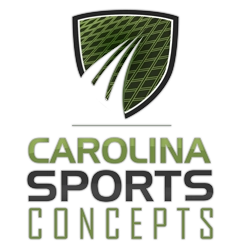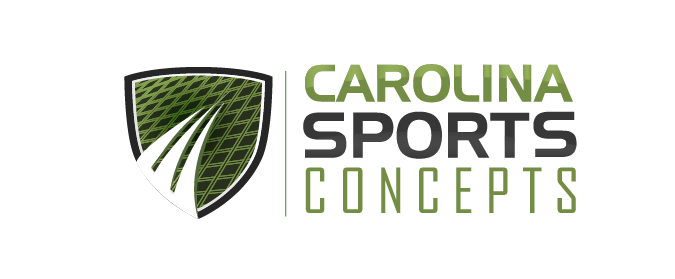Artificial turf is nothing new. But over the years, it has become a staple in more and more facilities and situations. There has to be a reason this material has become so popular, right? Actually, there are many reasons.
You’ve likely seen artificial grass in sports complexes or on commercial properties. Maybe you’ve even noticed the rising trend of artificial turf being used in residential landscaping. But if you want to know more about this synthetic material so that you can determine whether it would be ideal for your facility or property, you’ve come to the right place.
Below, Carolina Sports Concepts has laid out some critical details about artificial turf—from where it originated to why so many businesses and individuals are using it!
A Brief History
Artificial turf first gained attention in the 1960s when sports venues began using it. More specifically, it was introduced in ‘66 by way of the world’s first domed multipurpose stadium—the Houston Astrodome. Thus, the term “AstroTurf” was born.
It was attempted to use natural grass during the first half of the stadium’s inaugural year (‘65). But the grass simply wouldn’t grow, and the field conditions became so poor that artificial turf was installed in the middle of the Astros’ baseball season. More and more domed stadiums were built, and the demand for synthetic grass rose in the process.
Natural grass was initially attempted in other indoor stadiums during this era as well. But of course, live grass requires sunlight, which means that the stadiums’ roofs had to be constructed accordingly. Essentially, roof panels were designed to allow light to shine through. However, in order to reduce glare, some of the panels were painted over. As a result, the grass couldn’t be sustained.
It didn’t take long for this to manifest a negative impact on athletic performance. Over time, turf manufacturers became privy to the needs of the different types of sports and athletes. And they began to adapt their products to meet those demands.
The Material
As far as the material itself, artificial turf first came to the public in Europe, and it was initially fabricated with nylon. Later on, manufacturers started making it with polypropylene (PP) because it helped to reduce the risks of athletic injuries. PP remained the gold standard for turf material for many years.
As time went on, manufacturers worked to develop products that imitated real grass as closely as possible. This led to tufts becoming longer and sparser, as well as new styles being produced.
As more and more styles of artificial turf were introduced, new production technology followed. The standard material evolved from PP to polyethylene (PE).
PE makes for a more realistic-looking turf than those fabricated with PP. But PE is better for more reasons than aesthetics. It’s more versatile and serves as a more comfortable playing surface for all types of athletes. And it’s safer. Because high-quality turf enhances traction for a wide range of footwear, there is less stress transferred to the bodies of those who are using it.
What Makes Artificial Turf High Quality?
Speaking of “high-quality turf,” how do you know what makes good artificial grass? A few minutes of research will reveal many different types and brands of synthetic grass and greenery products on the market. Whether you’re thinking about installing turf at your sports facility, commercial property, or residential lawn, it’s essential that you choose a top-notch product that will look great for a long time.
The style of product that’s best for your situation will be contingent on your specific needs. This includes specifications like blade height, blade shape, thatching color, permeability, and density. The firmness also varies depending on the style of turf. For instance, firmer turf is typically used for sports to give athletes a more stable playing surface. On the other hand, turf installed on lawns is often on the softer side.
Despite your purposes for installing artificial turf, compare the materials used in each product you consider. Start by looking at the backing material. Polyurethane is widely regarded as being stronger and longer lasting than latex.
Also, you want to ensure that the product you choose is coated with a UV-resistant protectant to prevent fading; in some cases, turf without a protectant can even turn blue or white over time. Rather than having to replace your turf every few years, you likely want it to appear lush and green for the long term!
Another factor to consider when choosing a particular synthetic grass is that some products contain lead. If that grass is left to deteriorate, it can form dust and distribute harmful levels of lead to athletes and anyone else accessing the turf—adults and children alike. Moreover, there are various products manufactured in the United States, giving you ample opportunities to buy American.
What are the Benefits of Artificial Turf?
There are many benefits to using artificial turf in place of natural grass. While we have nothing against real grass, sometimes synthetic is simply the more practical choice! Here are a few of our reasons for recommending artificial turf to our customers:
It’s Versatile
Artificial turf is perhaps most commonly used in sports. The technology that goes into creating turf has been developed over decades of research, as well as trial and error, with the sole purpose of catering to a wide range of athletic activities and the athletes themselves. Along with coming in many different styles, all types of high-quality artificial grass can provide players with a safe and comfortable surface.
What’s more, turf can be used for non-sporting activities. Since it consists of predictable materials, you can use it all year round for a wide variety of functions.
It’s Durable
There’s something about the scent and look of natural grass when it comes to sports. But the fact is, natural grass can be destroyed in an instant. With a field full of players in cleats competing, it doesn’t take much for dips and holes to be created, which can pose serious risks to players, referees, and coaches.
Artificial turf is more durable than natural grass. It can endure more punishment and last much longer. Rarely does artificial turf need to be replaced after a game or a match—and that includes highly intense competitions at the professional level. If your sports complex installs artificial turf, you don’t have to worry about heavy traffic, major damage, or inclement weather becoming a problem.
The durability of artificial grass is also a major benefit to those who use it for their commercial or residential landscaping. Your property will look beautiful, healthy, and green for many years to come!
It’s Low-Maintenance
It doesn’t matter if you run a sports facility or take pride in having the most gorgeous lawn in the neighborhood. Natural grass requires a lot of maintenance. Artificial grass doesn’t. Not only does it eliminate the need to mow your lawn, but artificial grass doesn’t require pesticides or fertilizers.
Aside from hosing it off occasionally, the only time you’ll need to maintain your artificial grass is if it’s located under trees. Then you may need to brush off branches, nuts, and other debris from time to time. Another thing to consider is that synthetic grass is relatively easy to install, as it can be done in just a few steps. All things considered, it can save you a lot of time and resources.
It’s Cost-Effective
Think about how much it costs to maintain natural grass. Chemicals and equipment alone can run up your property maintenance bill. But you also have to consider how much money you spend on services like landscaping, mowing, and cleaning up after storms and snowy weather. You can eliminate all of those costs by installing artificial grass.
It’s Environmentally Friendly
Applying artificial turf is an eco-friendly solution to your sporting and landscaping needs. Consider the acreage of your field or lawn. If you’re using natural grass, how much water do you need to use to keep it sufficiently watered? However many acres are in question, it’s safe to say that it takes gallons upon gallons. With artificial grass, that’s not a problem because you only need to occasionally hose it off.
Furthermore, you don’t have to use pesticides, fertilizers, herbicides, emissions, or petrol—all of which could be harmful to the environment.
It’s Attractive
The most important aspect of any sports field is that it’s safe for athletes. But let’s not pretend that a lush, green surface doesn’t sweeten the deal! High-quality artificial grass looks clean and professional, especially if you choose a multi-tone product that looks more realistic.
Of course, when it comes to your commercial or residential lawn, appearance is the primary factor. By installing artificial grass, you can ensure that your property stays attractive year-round, which will significantly benefit you as a business owner or a homeowner.
What Kinds of Facilities Are Using Artificial Turf?
Artificial grass is currently being used in a wide range of facilities and properties. Let’s briefly discuss some of the most common ones:
Soccer Fields
If you have a soccer field, or even a small space in your backyard that you want to convert into a playing surface, applying artificial grass is ideal. It’s highly durable and weatherproof. And if you choose a top-tier product, it may even feel like playing on real grass.
Football Fields and Stadiums
Many football teams—from recreational to professional—play on artificial turf season after season. Along with being durable and weatherproof, it provides a consistent playing surface and is much easier and cheaper to maintain.
Baseball and Softball Fields
There are also plenty of indoor baseball and softball fields across the country that use artificial turf. Aside from hosting games, these fields can also be used to safely facilitate everything from team practices to camps to clinics.
Batting Cages
For baseball and softball players, batting cages are a quintessential training mechanism. When using natural grass, inclement weather can prevent players from being able to get their practice in. On the other hand, a batting cage with artificial grass will allow them to stay clean and safe without missing practice.
Indoor Driving Ranges and Putting Greens
Artificial grass is a much more practical option for driving ranges and putting greens. It’s comfortable, clean, and costs less to maintain, which means you can invest more money into other aspects of your business.
Fitness Facilities
More and more fitness centers are opting for artificial grass. Not only is it attractive, clean, and durable, but high-quality turf can accommodate a wide array of fitness styles and programs.
Playgrounds
Spending time in nature is critical for children. But when it comes to playgrounds, artificial grass is the clear winner. Along with being easier to maintain, it provides a more consistent, cushiony, and safer surface for kids at play. And if you want to add an extra layer of protection against slips and falls, installing shock pads will do the trick.
Other Places
You don’t need a sports or play facility to benefit from artificial grass. People everywhere are using it for their lawns, balconies, porches, pet runs, rooftops, interior design projects, and much more.
Conclusion
Carolina Sports Concepts love natural grass, but we’re not shy about our love for artificial turf either. It has become a popular solution for businesses and individuals around the world for a plethora of reasons. If you’re interested in learning more about artificial grass or would like to consult our team about having it installed on your property, be sure to visit our website or call us at (704) 658-6523!




